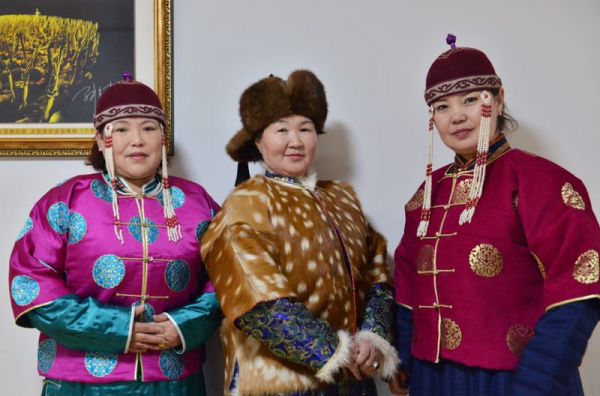Mongolian ethnic clothing weaves together tradition, innovation


Uyun (center) poses and takes selfies with her friends backstage at a traditional ethnic clothing competition in north China's Inner Mongolia Autonomous Region. Photo provided by Uyun
"We made all these clothes by hand. It's a family thing and a tradition on the prairie," said Uyun, 55, who teamed up with her friends for the competition at the 14th Mongolian Costume Festival held in the regional capital of Hohhot last week.
"As herders, we learned to make traditional Mongolian clothing as little girls," said Uyun, who is ethnic Mongolian from Hulun Buir City.
Temperatures in Hulun Buir can plummet to minus 40 degrees Celsius in winter.
"Only these, with lambswool lining, can help us keep warm," she said.
Uyun's friend, Ulangolwa, 53, said she taught her daughter the craft when she was young, and now the younger woman makes a living from it.
First held in 2003, the annual event aims to promote and protect Mongolian clothing. During this year's event, a seminar was held to discuss the status, trends, and protection of ethnic clothing.
Designer Ma Yonghua, owner of a Mongolian clothing company in Xingan League, was among the attendees.
The 27-year-old used to be a nurse and switched to costume design due to her passion for Mongolian clothing and tradition.
"I persuaded my parents and sold my apartment to fund the company," said Ma.
Ma said she respects tradition in making clothing. For example, cloud patterns should only be embroidered on the collar, rather than on trousers, to represent clouds' position in the sky and show awe of nature.
"In making Mongolian clothing, one should follow standards and know both how and why," Ma said.
While preserving the old, she is also creating new things.
Ma is working on Mongolian-style school uniforms featuring ethnic elements, but in soft and stretchy modern materials, rather than traditional leather and silk.
"Only when children love our traditional ethnic clothing will we be able to protect and develop it," said Zhang Yanru with the region's tourism development commission.
A competition for Mongolian-style primary and middle school uniforms was held for the first time during this year's festival, Zhang said.
In Xilingol League, the local government has established a "Mongolian Clothing Day" in Mongolian-language primary schools and kindergartens. On the day, students are encouraged to wear Mongolian clothing to school.
Courses on Mongolian clothing design and production are now offered in middle schools and vocational schools, said Uzhitunasun, director of the league's tourism development commission.
According to him, over 137,000 herders, or about a third of the population on the prairie in Xilingol League, still wear Mongolian clothing in their daily lives. More than 50,000 people in the league are engaged in Mongolian clothing production.
With a history of more than 800 years, Mongolian clothing was added to China's list of intangible cultural heritage in 2008. In 2012, the region issued a set of standards for making the clothing.
"Mongolian clothing is a symbol of Mongolians' nomadic life through history," said Zhang Yanru.
There are 28 Mongolian tribes in Inner Mongolia. Influenced by different climates, history and traditions, every tribe has unique clothing designs.
There is still a lack of designers of traditional Mongolian clothing, said Zhang Minghua, deputy director with Hohhot's tourism development commission.
Not many students majoring in costume design choose Mongolian clothing as their career, she said, "So we must encourage and train more students to do it."
MOST POPULAR
Editors' Picks
 Infographic:
Milestones in China's high-speed railway development
Infographic:
Milestones in China's high-speed railway development
 Infographic:
China's NEV industry performance review
Infographic:
China's NEV industry performance review
 Infographic:
China's low-altitude economy: A transformative force
Infographic:
China's low-altitude economy: A transformative force




